Quick Start for Confluent Platform
Use Confluent Platform and a few SQL statements to build a real-time application that processes example data streams.
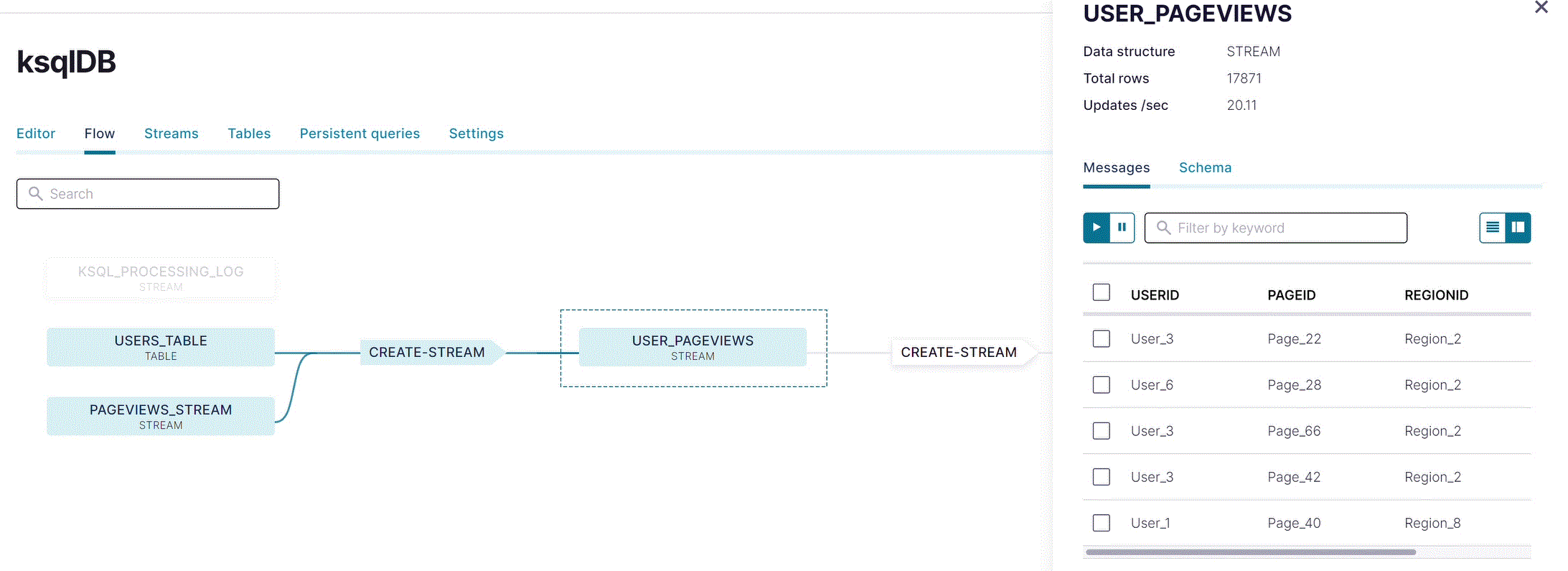
In this quick start, you will:
Install and run Confluent Platform and Apache Kafka®.
Generate real-time mock data.
Create topics to store your data.
Create real-time streams on your data.
Query and join streams with SQL statements.
Build a view that updates as new events arrive.
Visualize the topology of your streaming app.
When you finish, you’ll have a realtime app that consumes and processes data streams by using familiar SQL statements.
Tip
These steps use Docker or a tar archive, but there are other ways to install Confluent Platform, like package managers,
systemd, Kubernetes, and Ansible. For more information, see Install Confluent Platform On-Premises.If you would rather run Confluent in a fully managed environment, try the Confluent Cloud Quick Start.
Prerequisites
Installing Confluent Platform has different considerations and requirements, depending on whether you use Docker or a tar archive.
These steps use Docker and Docker Compose to download and run Confluent Platform.
- Considerations
Potentially longer download time, up to several minutes
Fewest steps to install and start
Requires
dockeranddocker-composeUninstall with
docker system prune
- Prerequisites
Docker
Docker version 1.11 or later is installed and running.
Docker Compose is installed. Docker Compose is installed by default with Docker for Mac and Docker for Windows.
On Mac: Docker memory is allocated minimally at 6 GB (Mac). When using Docker Desktop for Mac, the default Docker memory allocation is 2 GB. Change the default allocation to 6 GB in the Docker Desktop app by navigating to Preferences > Resources > Advanced.
Note
The Confluent Platform Quick Start is not supported on M1 Mac.
On Windows: Docker Desktop for Windows is running on WSL 2. For more information, see How to Run Confluent on Windows in Minutes.
Internet connectivity
Operating System currently supported by Confluent Platform
Networking and Kafka on Docker
Configure your hosts and ports to allow both internal and external components to the Docker network to communicate.
Install curl (optional).
In the following steps, you download a Docker Compose file. You can download this file any way you like, but the instructions below provide the specific
curlcommand you can use to download the file.
These steps use a tar archive to install Confluent Platform.
- Considerations
Fast download
More steps to install and start
Requires the
tarcommandMust add CONFLUENT_HOME to your path
Uninstall with
rm -rf
- Prerequisites
Internet connectivity
Operating System currently supported by Confluent Platform
A supported version of Java. Java 8 and Java 11 are supported in this version of Confluent Platform (Java 9 and 10 are not supported). For more information, see Java supported versions.
Note
The Confluent Platform Quick Start is not supported on M1 Mac.
Step 1: Download and start Confluent Platform
In this step, you download the Confluent Platform binaries, either as Docker images or as an archive file.
Download or copy the contents of the Confluent Platform all-in-one Docker Compose file, for example:
curl --silent --output docker-compose.yml \ https://raw.githubusercontent.com/confluentinc/cp-all-in-one/7.3.15-post/cp-all-in-one/docker-compose.yml
Start the Confluent Platform stack with the
-doption to run in detached mode:docker-compose up -d
Each Confluent Platform component starts in a separate container. Your output should resemble:
Creating network "cp-all-in-one_default" with the default driver Creating zookeeper ... done Creating broker ... done Creating schema-registry ... done Creating rest-proxy ... done Creating connect ... done Creating ksql-datagen ... done Creating ksqldb-server ... done Creating control-center ... done Creating ksqldb-cli ... done
Verify that the services are up and running:
docker-compose psYour output should resemble:
Name Command State Ports ------------------------------------------------------------------------------------------ broker /etc/confluent/docker/run Up 0.0.0.0:29092->29092/tcp, 0.0.0.0:9092->9092/tcp connect /etc/confluent/docker/run Up 0.0.0.0:8083->8083/tcp, 9092/tcp control-center /etc/confluent/docker/run Up 0.0.0.0:9021->9021/tcp ksqldb-cli /bin/sh Up ksql-datagen bash -c echo Waiting for K ... Up ksqldb-server /etc/confluent/docker/run Up 0.0.0.0:8088->8088/tcp rest-proxy /etc/confluent/docker/run Up 0.0.0.0:8082->8082/tcp schema-registry /etc/confluent/docker/run Up 0.0.0.0:8081->8081/tcp zookeeper /etc/confluent/docker/run Up 0.0.0.0:2181->2181/tcp, 2888/tcp, 3888/tcpAfter a few minutes, if the state of any component isn’t Up, run the
docker-compose up -dcommand again, or trydocker-compose restart <image-name>, for example:docker-compose restart control-center
Download the
confluent-7.3.15.tar.gzpackage from the Confluent package archive.Tip
On the Installation Type page, you have more installation options:
Ansible, Docker, and Kubernetes for distributed architectures
Previous Versions of Confluent Platform
The Community version of Confluent Platform
Use the
tarcommand to decompress the archive file.tar -xvf confluent-7.3.15.tar.gz
The
tarcommand creates theconfluent-7.3.15directory, which is the Confluent home directory. Run thelscommand to examine its contents:ls -al confluent-7.3.15
Your output should resemble:
-rw-r--r-- 1 jim jim 871 May 19 21:36 README drwxr-xr-x 3 jim jim 4096 May 19 20:25 bin drwxr-xr-x 17 jim jim 4096 May 19 20:25 etc drwxr-xr-x 3 jim jim 4096 May 19 20:21 lib drwxr-xr-x 3 jim jim 4096 May 19 20:25 libexec drwxr-xr-x 7 jim jim 4096 May 19 20:25 share drwxr-xr-x 2 jim jim 4096 May 19 21:36 src
Set the environment variable for the Confluent Platform home directory.
export CONFLUENT_HOME=confluent-7.3.15
Add the Confluent Platform
bindirectory to your PATH.export PATH=$PATH:$CONFLUENT_HOME/bin
Test that you set the
CONFLUENT_HOMEvariable correctly by running theconfluentcommand:confluent --helpYour output should show the available commands for managing Confluent Platform.
Install the Kafka Connect Datagen source connector by using the Confluent Marketplace client. This connector generates mock data for demonstration purposes only and is not suitable for production.
confluent-hub install \ --no-prompt confluentinc/kafka-connect-datagen:latest
Tip
Confluent Hub is an online library of pre-packaged and ready-to-install extensions or add-ons for Confluent Platform and Kafka.
Start Confluent Platform by using the Confluent CLI confluent local services start command. This command starts all of the Confluent Platform components, including Kafka, ZooKeeper, Schema Registry, HTTP REST Proxy for Kafka, Kafka Connect, ksqlDB, and Control Center (Legacy).
Important
The confluent local commands are intended for a single-node development environment and are not suitable for a production environment. The data that are produced are transient and are intended to be temporary. For production-ready workflows, see Install and Upgrade Confluent Platform.
confluent local start
Your output should resemble:
Starting Zookeeper Zookeeper is [UP] Starting Kafka Kafka is [UP] Starting Schema Registry Schema Registry is [UP] Starting Kafka REST Kafka REST is [UP] Starting Connect Connect is [UP] Starting KSQL Server KSQL Server is [UP] Starting Control Center Control Center is [UP]
Step 2: Create Kafka topics for storing your data
In Confluent Platform, realtime streaming events are stored in a Kafka topic, which is essentially an append-only log. For more info, see the Apache Kafka Introduction.
In this step, you create two topics by using Confluent Control Center (Legacy). Control Center (Legacy) provides the features for building and monitoring production data pipelines and event streaming applications.
The topics are named pageviews and users. In later steps, you create data generators that produce data to these topics.
Create the pageviews topic
Confluent Control Center (Legacy) enables creating topics in the UI with a few clicks.
Navigate to Control Center (Legacy) at http://localhost:9021. It may take a minute or two for Control Center (Legacy) to start and load.
Click the controlcenter.cluster tile.

In the navigation menu, click Topics to open the topics list. Click Add a topic to start creating the
pageviewstopic.
In the Topic name field, enter
pageviewsand click Create with defaults. Topic names are case-sensitive.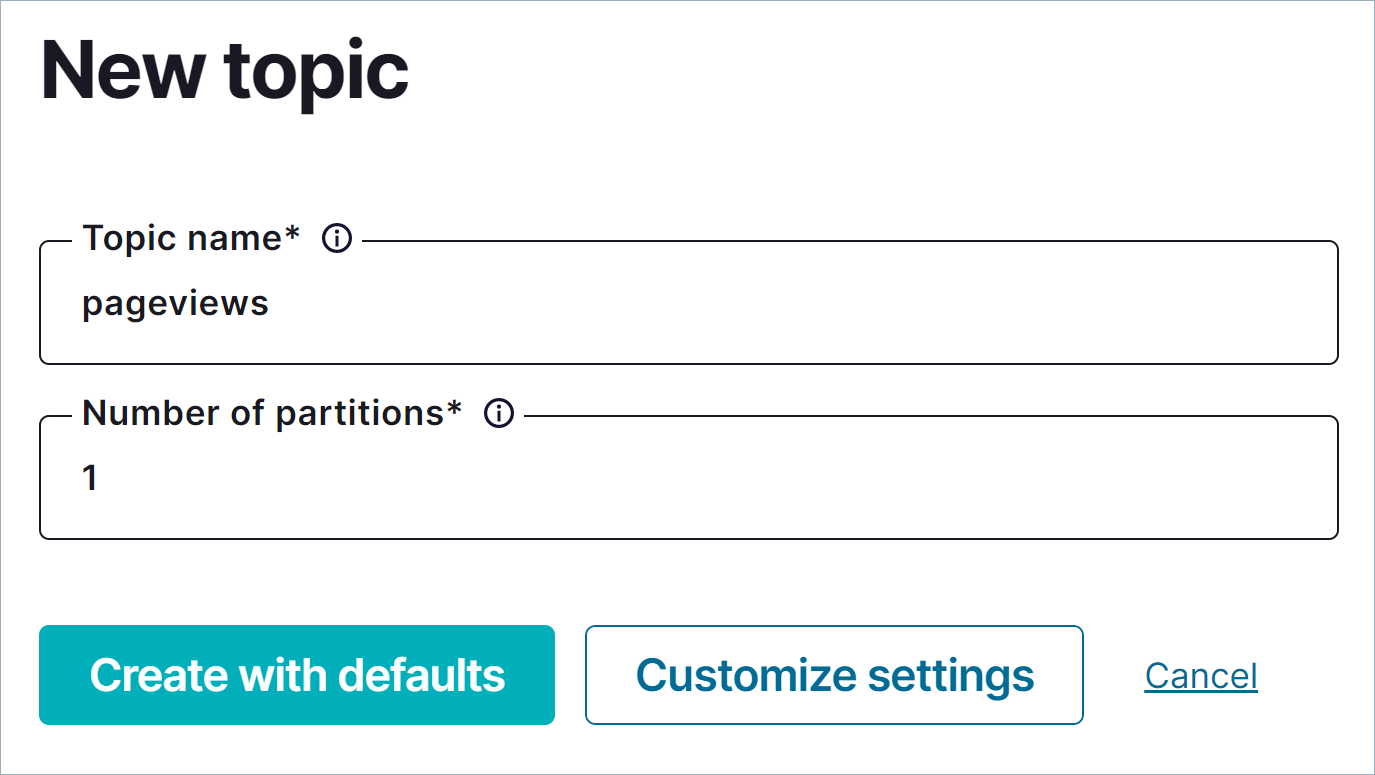
Create the users topic
Repeat the previous steps to create the users topic.
Step 3: Generate mock data
In Confluent Platform, you get events from an external source by using a connector, which enables streaming large volumes of data to and from your cluster. Confluent publishes many connectors for integrating with external systems, like MongoDb and Elasticsearch. For more information, see the Kafka Connect Overview page.
In this step, you run the Datagen Source Connector to generate mock data. The mock data is stored in the pageviews and users topics that you created previously.
In the navigation menu, click Connect.
Click the
connect-defaultcluster in the Connect clusters list.Click Add connector to start creating a connector for pageviews data.
Select the
DatagenConnectortile.Tip
To see source connectors only, click Filter by category and select Sources.
In the Name field, enter
datagen-pageviewsas the name of the connector.Enter the following configuration values:
Key converter class:
org.apache.kafka.connect.storage.StringConverter.kafka.topic:
pageviews.max.interval:
100.quickstart:
pageviews.
Click Next to review the connector configuration. When you’re satisfied with the settings, click Launch.
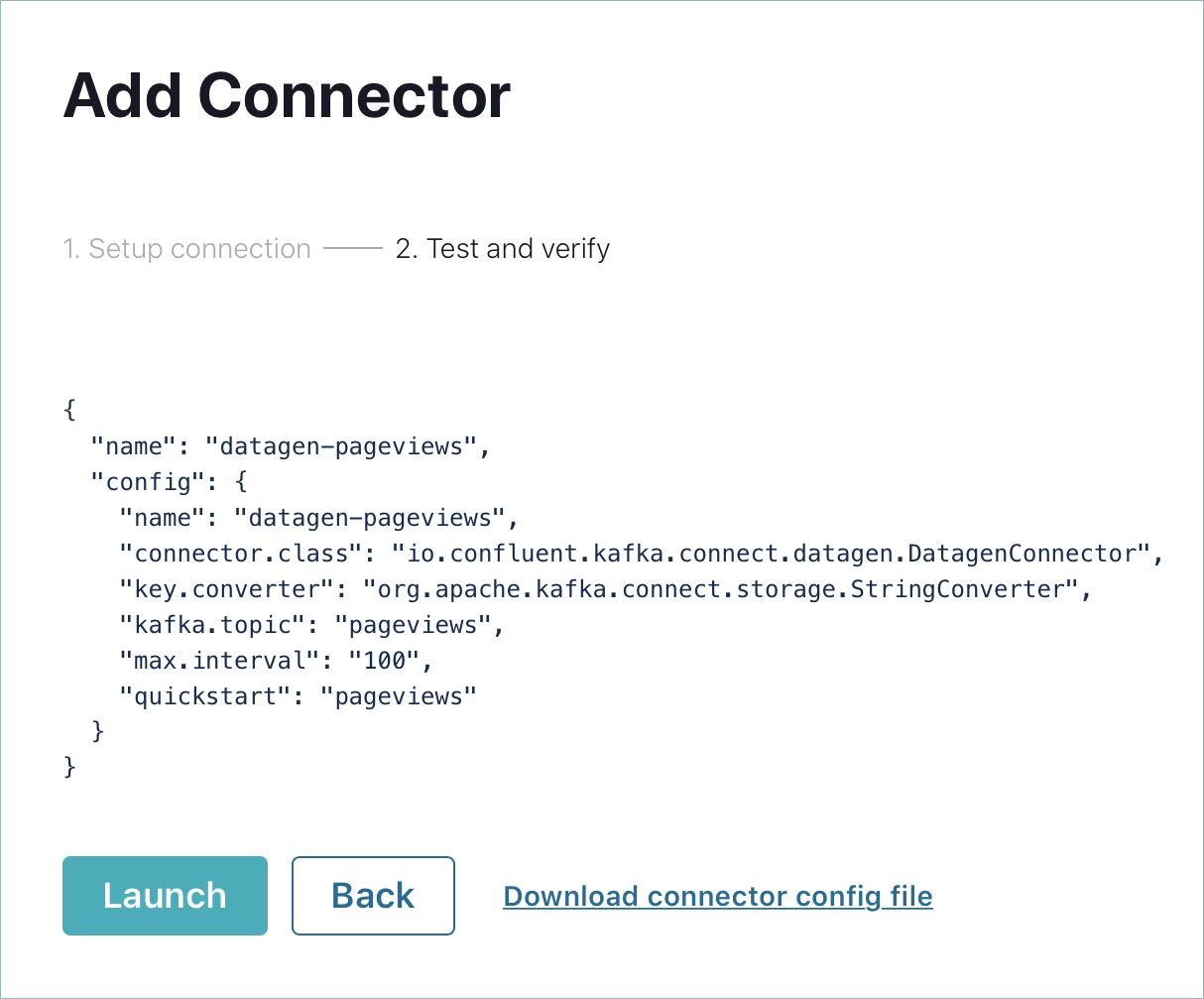
Run a second instance of the Datagen Source connector connector to produce mock data to the users topic.
In the navigation menu, click Connect.
In the Connect clusters list, click
connect-default.Click Add connector.
Select the
DatagenConnectortile.In the Name field, enter
datagen-usersas the name of the connector.Enter the following configuration values:
Key converter class:
org.apache.kafka.connect.storage.StringConverterkafka.topic:
usersmax.interval:
1000quickstart:
users
Click Next to review the connector configuration. When you’re satisfied with the settings, click Launch.
In the navigation menu, click Topics and in the list, click users.
Click Messages to confirm that the
datagen-usersconnector is producing data to theuserstopic.
Inspect the schema of a topic
By default, the Datagen Source Connector produces data in Avro format, which defines the schemas of pageviews and users messages.
Schema Registry ensures that messages sent to your cluster have the correct schema. For more information, see Schema Registry for Confluent Platform.
In the navigation menu, click Topics, and in the topic list, click pageviews.
Click Schema to inspect the Avro schema that applies to
pageviewsmessage values.Your output should resemble:
{ "connect.name": "ksql.pageviews", "fields": [ { "name": "viewtime", "type": "long" }, { "name": "userid", "type": "string" }, { "name": "pageid", "type": "string" } ], "name": "pageviews", "namespace": "ksql", "type": "record" }
Step 4: Create a stream and table by using SQL statements
In this step, you create a stream for the pageviews topic and a table for the users topic by using familiar SQL syntax. When you register a stream or a table on a topic, you can use the stream/table in SQL statements.
Note
A stream is a an immutable, append-only collection that represents a series of historical facts, or events. Once a row is inserted into a stream, the row can never change. You can append new rows at the end of the stream, but you can’t update or delete existing rows.
A table is a mutable collection that models change over time. It uses row keys to display the most recent data for each key. All but the newest rows for each key are deleted periodically. Also, each row has a timestamp, so you can define a windowed table which enables controlling how to group records that have the same key for stateful operations – like aggregations and joins – into time spans. Windows are tracked by record key.
Together, streams and tables comprise a fully realized database. For more information, see Stream processing.
The SQL engine is implemented in ksqlDB, the purpose-built database for stream processing applications. The following steps show how to create a ksqlDB application, which enables processing real-time data with familiar SQL syntax.
This example app shows these stream processing operations.
JOIN the
pageviewsstream with theuserstable to create an enriched stream of pageview events.Filter the enriched stream by the
regionfield.Create a windowed view on the filtered stream that shows the most recently updated rows. The window has a SIZE of 30 seconds.
Tip
These processing steps are implemented with only three SQL statements.
The following steps show how use the CREATE STREAM and CREATE TABLE statements to register a stream on the pageviews topic and a table on the users topic. Registering a stream or a table on a topic enables SQL queries on the topic’s data.
In the navigation menu, click ksqlDB.
Click the
ksqlDBapplication to open the ksqlDB page. There are tabs for editing SQL statements and for monitoring the streams and tables that you create.Copy the following SQL into the editor window. This statement registers a stream, named
pageviews_stream, on thepageviewstopic. Stream and table names are not case-sensitive.CREATE STREAM pageviews_stream WITH (KAFKA_TOPIC='pageviews', VALUE_FORMAT='AVRO');
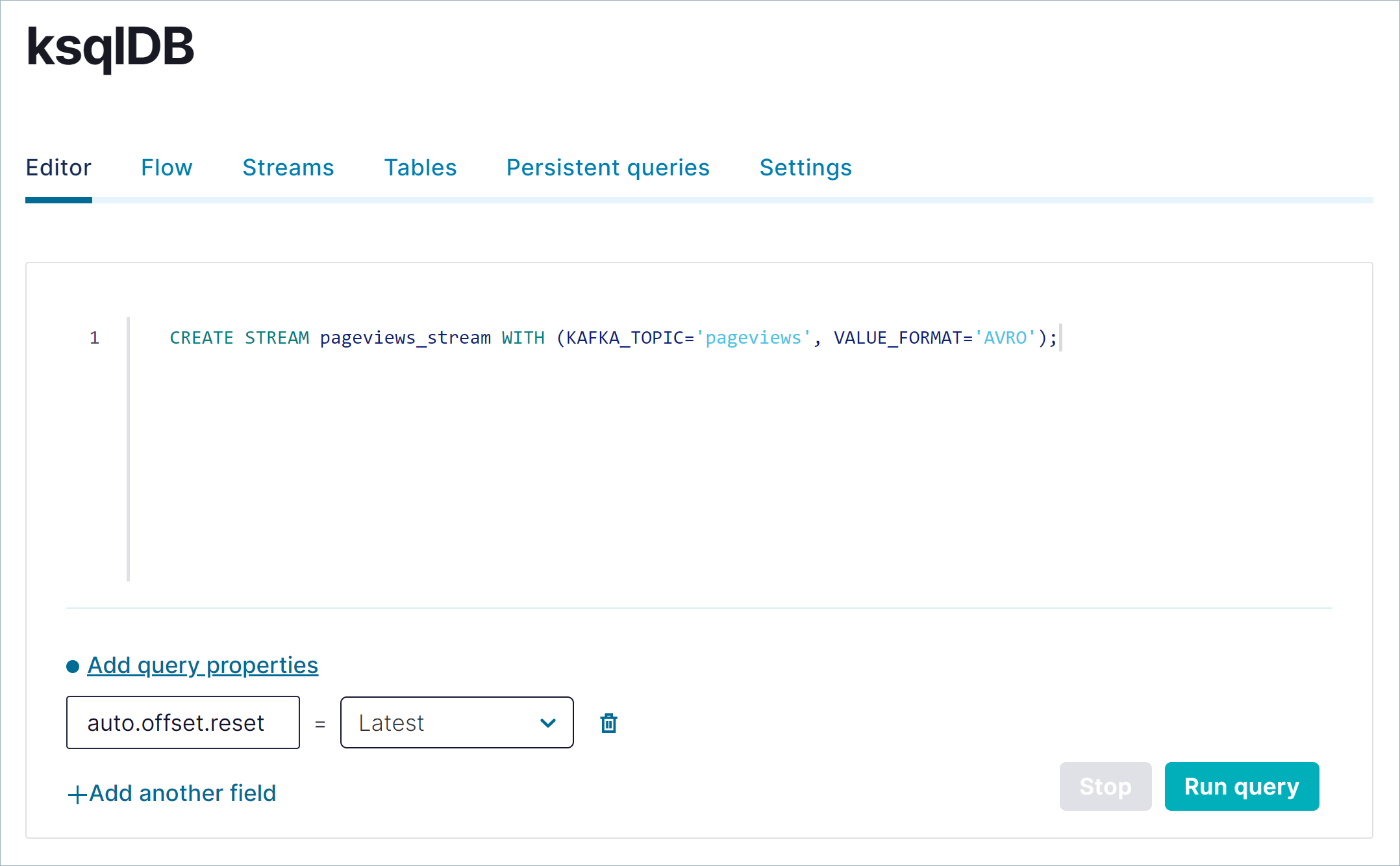
Click Run query to execute the statement. In the result window, your output should resemble:
{ "@type": "currentStatus", "statementText": "CREATE STREAM PAGEVIEWS_STREAM (VIEWTIME BIGINT, USERID STRING, PAGEID STRING) WITH (KAFKA_TOPIC='pageviews', KEY_FORMAT='KAFKA', VALUE_FORMAT='AVRO', VALUE_SCHEMA_ID=2);", "commandId": "stream/`PAGEVIEWS_STREAM`/create", "commandStatus": { "status": "SUCCESS", "message": "Stream created", "queryId": null }, "commandSequenceNumber": 2, "warnings": [] }
Use a SELECT query to confirm that data is moving through your stream. Copy the following SQL into the editor and click Run query.
SELECT * FROM pageviews_stream EMIT CHANGES;
Your output should resemble:

Click Stop to end the SELECT query.
Important
Stopping the SELECT query doesn’t stop data movement through the stream.
Copy the following SQL into the editor window and click Run query. This statement registers a table, named
users_table, on theuserstopic.CREATE TABLE users_table (id VARCHAR PRIMARY KEY) WITH (KAFKA_TOPIC='users', VALUE_FORMAT='AVRO');
Your output should resemble:
{ "@type": "currentStatus", "statementText": "CREATE TABLE USERS_TABLE (ID STRING PRIMARY KEY, REGISTERTIME BIGINT, USERID STRING, REGIONID STRING, GENDER STRING) WITH (KAFKA_TOPIC='users', KEY_FORMAT='KAFKA', VALUE_FORMAT='AVRO', VALUE_SCHEMA_ID=2);", "commandId": "table/`USERS_TABLE`/create", "commandStatus": { "status": "SUCCESS", "message": "Table created", "queryId": null }, "commandSequenceNumber": 4, "warnings": [] }
A table requires you to specify a PRIMARY KEY when you register it. In ksqlDB, a table is similar to tables in other SQL systems: a table has zero or more rows, and each row is identified by its PRIMARY KEY.
Inspect the schemas of your stream and table
Schema Registry is installed with Confluent Platform and is running in the stack, so you don’t need to specify message schemas in your CREATE STREAM and CREATE TABLE statements. For the Avro, JSON_SR, and Protobuf formats, Schema Registry infers schemas automatically.
Click Streams to see the currently registered streams. In the list, click PAGEVIEWS_STREAM to see details about the stream.
In the Schema section, you can see the field names and types for the message values produced by the
datagen-pageviewsconnector.
Click Tables to see the currently registered tables. In the list, click USERS_TABLE to see details about the table.
In the Schema section, you can see the field names and types for the message values produced by the
datagen-usersconnector.
Create queries to process data
In this step, you write SQL queries that inspect and process pageview and user rows. You can create different kinds of queries.
Transient query: a non-persistent, client-side query that you terminate manually or with a LIMIT clause. A transient query doesn’t create a new topic.
Persistent query: a server-side query that outputs a new stream or table that’s backed by a new topic. It runs until you issue the TERMINATE statement. The syntax for a persistent query uses the CREATE STREAM AS SELECT or CREATE TABLE AS SELECT statements.
Push query: A query that produces results continuously to a subscription. The syntax for a push query uses the EMIT CHANGES keyword. Push queries can be transient or persistent.
Pull query: A query that gets a result as of “now”, like a query against a traditional relational database. A pull query runs once and returns the current state of a table. Tables are updated incrementally as new events arrive, so pull queries run with predictably low latency. Pull queries are always transient.
Query for pageviews
Click Editor to return to the query editor.
Copy the following SQL into the editor and click Run query. This statement creates a transient query that returns three rows from
pageviews_stream.SELECT pageid FROM pageviews_stream EMIT CHANGES LIMIT 3;
Your output should resemble:

Click the Card view or Table view icon to change the layout of the output.
Join your stream and table
In this step, you create a stream named user_pageviews by using a persistent query that joins pageviews_stream with users_table on the userid key. This join enriches pageview data with information about the user who viewed the page. The joined rows are written to a new sink topic, which has the same name as the new stream, by default.
Tip
You can specify the name of the sink topic by using the KAFKA_TOPIC keyword in a WITH clause.
The following steps show how to join a stream with a table and view the resulting stream’s output.
Copy the following SQL into the editor and click Run query.
CREATE STREAM user_pageviews AS SELECT users_table.id AS userid, pageid, regionid, gender FROM pageviews_stream LEFT JOIN users_table ON pageviews_stream.userid = users_table.id EMIT CHANGES;
Your output should resemble:
{ "@type": "currentStatus", "statementText": "CREATE STREAM USER_PAGEVIEWS WITH (KAFKA_TOPIC='USER_PAGEVIEWS', PARTITIONS=1, REPLICAS=1) AS SELECT\n USERS_TABLE.ID USERID,\n PAGEVIEWS_STREAM.PAGEID PAGEID,\n USERS_TABLE.REGIONID REGIONID,\n USERS_TABLE.GENDER GENDER\nFROM PAGEVIEWS_STREAM PAGEVIEWS_STREAM\nLEFT OUTER JOIN USERS_TABLE USERS_TABLE ON ((PAGEVIEWS_STREAM.USERID = USERS_TABLE.ID))\nEMIT CHANGES;", "commandId": "stream/`USER_PAGEVIEWS`/create", "commandStatus": { "status": "SUCCESS", "message": "Created query with ID CSAS_USER_PAGEVIEWS_5", "queryId": "CSAS_USER_PAGEVIEWS_5" }, "commandSequenceNumber": 6, "warnings": [] }
Tip
The highlighted lines in the output show that the query’s internal identifier is
CSAS_USER_PAGEVIEWS_5and is prepended with “CSAS”, which stands for CREATE STREAM AS SELECT.Identifiers for tables are prepended with “CTAS”, which stands for CREATE TABLE AS SELECT.
Click Streams to open the list of streams that you can access.
Select USER_PAGEVIEWS, and click Query stream.
The editor opens with a transient SELECT query, and streaming output from the
user_pageviewsstream displays in the result window. The joined stream has all fields frompageviews_streamandusers_table.Note
The query uses the EMIT CHANGES syntax, which indicates that this is a push query. A push query enables you to query a stream or table with a subscription to the results. It continues until you stop it. For more information, see Push queries.
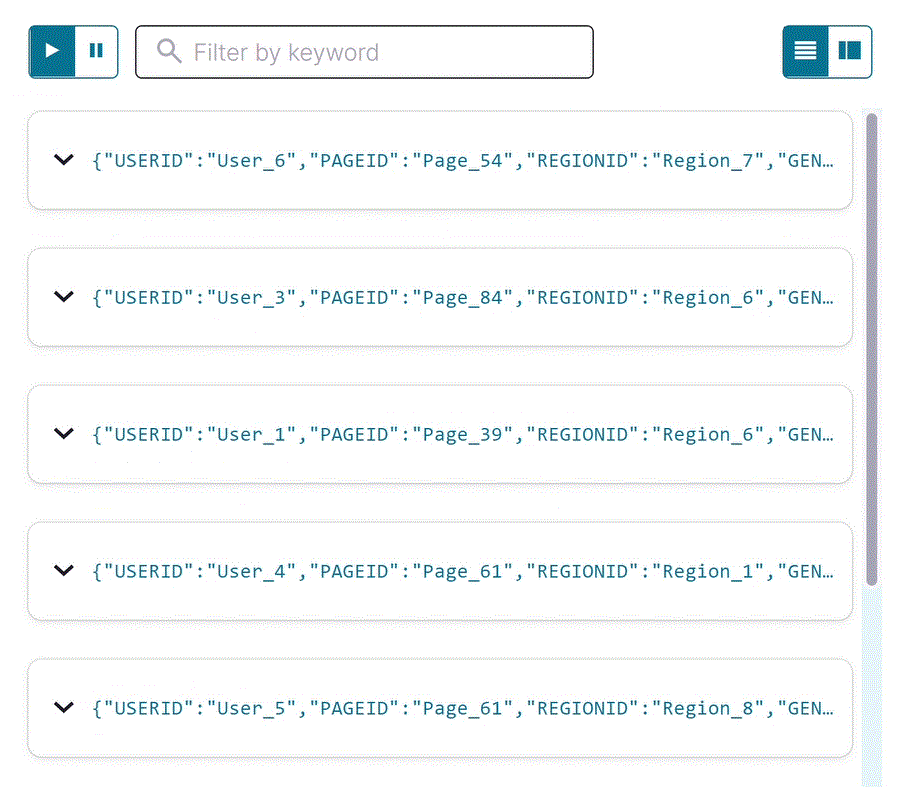
Click Stop to end the transient push query.
Filter a stream
In this step, you create a stream, named pageviews_region_like_89, which is made of user_pageviews rows that have a regionid value that ends with 8 or 9. Results from this query are written to a new topic, named pageviews_filtered_r8_r9. The topic name is specified explicitly in the query by using the KAFKA_TOPIC keyword.
Copy the following SQL into the editor and click Run query.
CREATE STREAM pageviews_region_like_89 WITH (KAFKA_TOPIC='pageviews_filtered_r8_r9', VALUE_FORMAT='AVRO') AS SELECT * FROM user_pageviews WHERE regionid LIKE '%_8' OR regionid LIKE '%_9' EMIT CHANGES;
Your output should resemble:
{ "@type": "currentStatus", "statementText": "CREATE STREAM PAGEVIEWS_REGION_LIKE_89 WITH (KAFKA_TOPIC='pageviews_filtered_r8_r9', PARTITIONS=1, REPLICAS=1, VALUE_FORMAT='AVRO') AS SELECT *\nFROM USER_PAGEVIEWS USER_PAGEVIEWS\nWHERE ((USER_PAGEVIEWS.REGIONID LIKE '%_8') OR (USER_PAGEVIEWS.REGIONID LIKE '%_9'))\nEMIT CHANGES;", "commandId": "stream/`PAGEVIEWS_REGION_LIKE_89`/create", "commandStatus": { "status": "SUCCESS", "message": "Created query with ID CSAS_PAGEVIEWS_REGION_LIKE_89_7", "queryId": "CSAS_PAGEVIEWS_REGION_LIKE_89_7" }, "commandSequenceNumber": 8, "warnings": [] }
Inspect the filtered output of the
pageviews_region_like_89stream. Copy the following SQL into the editor and click Run query.SELECT * FROM pageviews_region_like_89 EMIT CHANGES;
Your output should resemble:

Create a windowed view
In this step, you create a table named pageviews_per_region_89 that counts the number of pageviews from regions 8 and 9 in a tumbling window with a SIZE of 30 seconds. The query result is an aggregation that counts and groups rows, so the result is a table, instead of a stream.
Copy the following SQL into the editor and click Run query.
CREATE TABLE pageviews_per_region_89 WITH (KEY_FORMAT='JSON') AS SELECT userid, gender, regionid, COUNT(*) AS numusers FROM pageviews_region_like_89 WINDOW TUMBLING (SIZE 30 SECOND) GROUP BY userid, gender, regionid HAVING COUNT(*) > 1 EMIT CHANGES;
Your output should resemble:
{ "@type": "currentStatus", "statementText": "CREATE TABLE PAGEVIEWS_PER_REGION_89 WITH (KAFKA_TOPIC='PAGEVIEWS_PER_REGION_89', KEY_FORMAT='JSON', PARTITIONS=1, REPLICAS=1) AS SELECT\n PAGEVIEWS_REGION_LIKE_89.GENDER GENDER,\n PAGEVIEWS_REGION_LIKE_89.REGIONID REGIONID,\n COUNT(*) NUMUSERS\nFROM PAGEVIEWS_REGION_LIKE_89 PAGEVIEWS_REGION_LIKE_89\nWINDOW TUMBLING ( SIZE 30 SECONDS ) \nGROUP BY PAGEVIEWS_REGION_LIKE_89.GENDER, PAGEVIEWS_REGION_LIKE_89.REGIONID\nHAVING (COUNT(*) > 1)\nEMIT CHANGES;", "commandId": "table/`PAGEVIEWS_PER_REGION_89`/create", "commandStatus": { "status": "SUCCESS", "message": "Created query with ID CTAS_PAGEVIEWS_PER_REGION_89_9", "queryId": "CTAS_PAGEVIEWS_PER_REGION_89_9" }, "commandSequenceNumber": 10, "warnings": [] }
Inspect the windowed output of the
pageviews_per_region_89table. Copy the following SQL into the editor and click Run query.SELECT * FROM pageviews_per_region_89 EMIT CHANGES;
Click the table view button (
 ).
).Your output should resemble:

The NUMUSERS column shows the count of users who clicked within each 30-second window.
Snapshot a table by using a pull query
You can get the current state of a table by using a pull query, which returns rows for a specific key at the time you issue the query. A pull query runs once and terminates.
In the step, you query the pageviews_per_region_89 table for all rows that have User_1 in Region_9.
Copy the following SQL into the editor and click Run query.
SELECT * FROM pageviews_per_region_89
WHERE userid = 'User_1' AND gender='FEMALE' AND regionid='Region_9';
Your output should resemble:

Inspect your streams and tables
In the upper-right corner of the editor, the All available streams and tables pane shows all of the streams and tables that you can access. Click PAGEVIEWS_PER_REGION_89 to see the fields in the
pageviews_per_region_89table.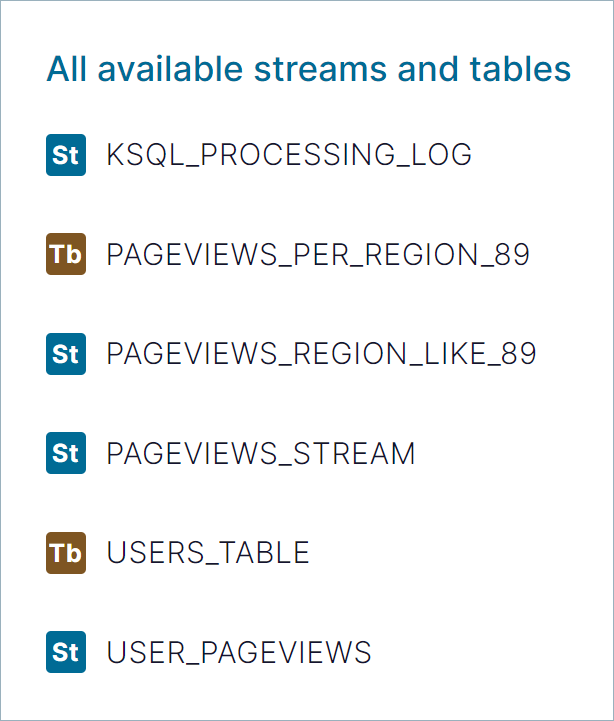
In the All available streams and tables section, click KSQL_PROCESSING_LOG to view the fields in the processing log, including nested data structures. The processing log shows errors that occur when your SQL statements are processed. You can query it like any other stream. For more information, see Processing log
Click Persistent queries to inspect the streams and tables that you’ve created.

Use this page to check whether your queries are running, to explain a query, and to terminate running queries.
Step 5: Visualize your app’s stream topology
In the streaming application you’ve built, events flow from the Datagen connectors into the pageviews and users topics. Rows are processed with a join and filtered, and in the final step, rows are aggregated in a table view of the streaming data.
You can see an end-to-end view of the whole system by using Flow view.
Step 6: Uninstall and clean up
When you’re done exploring Confluent Platform, you can remove it easily to free storage and other system resources.
When you’re done working with Docker, you can stop and remove Docker containers and images.
Run the following command to stop the Docker containers for Confluent:
docker-compose stopAfter stopping the Docker containers, run the following commands to prune the Docker system. Running these commands deletes containers, networks, volumes, and images, freeing up disk space:
docker system prune -a --volumes --filter "label=io.confluent.docker"
For more information, refer to the official Docker documentation.
When you’re done working with the local installation, you can stop Confluent Platform.
Stop Confluent Platform using the Confluent CLI confluent local services connect stop command.
confluent local services stop
Delete the data in the Confluent Platform instance by using the confluent local destroy command.
confluent local destroy
Next Steps
Run an automated version of this quick start designed for Confluent Platform local installs.
Confluent Developer: Learn to program Confluent Platform from the many courses offered there.
Confluent Education: Find training and certification guidance, including resources, as well as access to hands-on training and certification exams.
AWS Workshop: Use fully-managed Confluent Cloud on AWS to create a sample app that processes credit applications in real time.
ksqlDB documentation: Learn about processing your data with ksqlDB for use cases such as streaming ETL, real-time monitoring, and anomaly detection. You can also learn how to use ksqlDB with this collection of scripted demos.
Kafka Tutorials: Try out basic Kafka, Kafka Streams, and ksqlDB tutorials with step-by-step instructions.
Kafka Streams documentation: Learn how to build stream processing applications in Java or Scala.
Kafka Connect documentation: Learn how to integrate Kafka with other systems and download ready-to-use connectors to easily ingest data in and out of Kafka in real-time.
Kafka Clients documentation: Learn how to read and write data to and from Kafka using programming languages such as Go, Python, .NET, C/C++.
